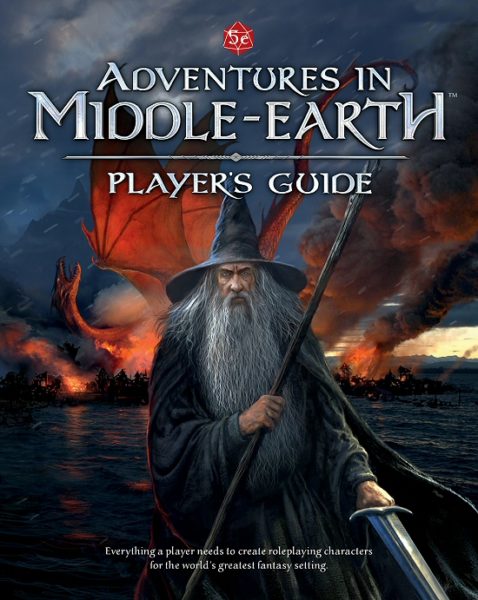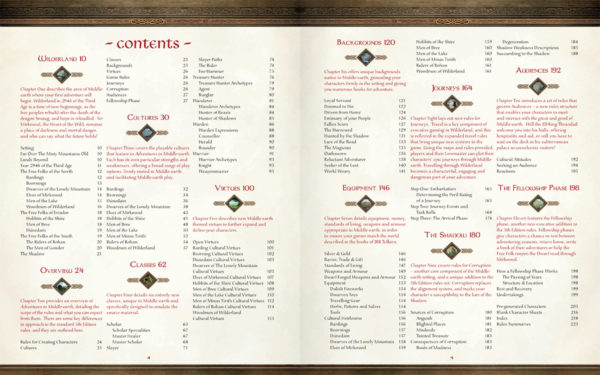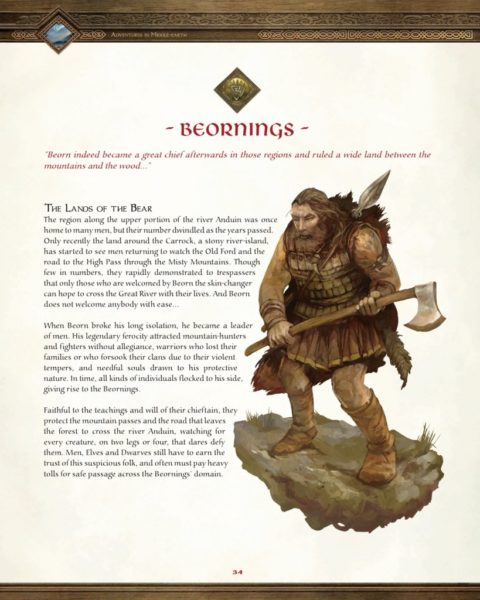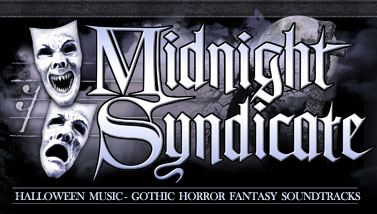DDO Players Adventures in Middle-earth Player’s Guide Review
Smaug has been defeated, the Battle of Five Armies has been won, and Bilbo has returned to the Shire. But much danger still remains, and from the Orc-holds of the mountains to the dark and corrupt depths of Mirkwood a darkness waits, recovering its strength, laying its plans, and slowly extending its shadow…
In Dale, King Bard sends out a call for brave adventurers to journey to Laketown and assist him in restoring the glory of the North.
For those of you that know your D&D history you know, that in 1974, when D&D creator Gary Gygax included hobbits as a player character race, the Tolkien Estate & Middle-earth Enterprises were not amused and threatened to sue if the hobbits were not removed from the game. Since that day Tolkien and Middle-earth have never been together, until now that is.
*Note – This review is based upon the 2nd Revision PDF*
Cubicle 7 is not stranger the lands and world of Middle-earth as they already has a Lord of the Rings RPG: The One Ring, which is an amazing RPG in its own right, but how will they bring ME to D&D 5E?
Adventures in Middle-earth Player’s Guide (Which I will refer to as AME for the reminder of this review) is currently available in pdf and print preorder (which will also get you the pdf version); the book version will be available soon, With the Adventures in Middle-earth Loremaster’s Guide (Dungeon Master) is due to follow later this fall.
The Player’s Guide is as a 224-page full-color pdf, Amazing artwork and fully bookmarked for easy searching. Note – You will also get an iPad formatted PDF as well, which was a pleasant surprise, and most welcomed. The way it reads and the “feel” of the book really invokes the world of Tolkien and Middle-earth.
The Full Break down
The book is laid out into 11 different chapters
Chapter One gives you the information about the significance of 2946 in the Third Age and overview of the Free Folk of the North, the Free Folk of Eriador, the Free Folk of the South and the activities of the Shadow.
Chapter Two explains how the rules of Adventures in Middle-earth Player’s differs from standard D&D 5th Edition game. It contains rules for creating characters, the Cultures of Middle-earth, the classes this book introduces, Middle-earth Backgrounds, Virtues, the Game Rules, Journeys, Corruption, Audiences, and the Fellowship Phase.
Chapter Three are the Cultures of Middle-earth, which take the place of 5th Edition’s Races. The cultures detailed are Bardings, Beornings, the Dunedin, Dwarves of the Lonely Mountain (further defined by Erebor and the Iron Hills), Elves of Mirkwood, Hobbits of the Shire (further defined by Harfoot and Stoor), Men of Bree, Men of the Lake, Men of Minas Tirith, the Riders of Rohan, and the Woodmen of the Wilderland.
Chapter Four introduces the Classes unique to AMe.
Chapter Five covers Virtues which are AMe’s term for Feats. Virtues are specific to a Culture, they are well designed and constructed and could easily add new options for a standard 5th Edition game.
Chapter Six details the Backgrounds of AME, and each includes a character’s Hope and Despair to really dig deep into the lore of the setting. The Backgrounds are Loyal Servant, Doomed to Die, Driven from Home, Emissary of your People, Fallen Scion, The Harrowed, Hunted by the Shadow, Lure of the Road, The Magician (a performer), Oathsworn, Reluctant Adventurer, Seeker of the Lost, and World Weary.
Chapter Seven Covers Equipment, detailing such things as Dalish Fireworks, Dwarven Toys, and Cultural Heirlooms. Cultural Heirlooms cannot be purchased, only rewarded, and they take the place of 5th Edition’s magic items. Heirlooms for each Culture are provided.
Chapter Eight introduces the rules for Journeys, as travel is greatly emphasized in Middle-earth.
Chapter Nine details the Shadow and the Corruption mechanic is fully presented. Each Classes’ Shadow Weakness is detailed, as well. Consequences of Corruption, such as madness and degeneration are detailed.
Chapter Ten Covers Audiences, a rules sub-system for meeting with and seeking aid from some of the “big names” in Middle-earth, those that we have all read about or watched on film.
Chapter Eleven covers the Fellowship Phase, which adds another rules sub-system for allowing character to recover between seasons and helps flesh out what they were up to when they have gone their separate ways, sometimes for years at a time. It includes options for Rest and Recovery, Undertakings (accomplishments important to individual heroes), Training, Gaining a New Trait (a fundamental change to the character), Heal Corruption, Meet a Patron, Open a Sanctuary, Receive a Title, and Research Lore.
You Got Your Middle-Earth IN My D&D!
Characters options is where this book really shines, The Player’s Guide uses well over half of its page count to present an almost entirely new system of character creation.
PCs have the same six attributes (Strength, Dexterity, etc.) you’d expect.
The choice of race expands into culture. You will gain abilities unique to each homeland
There are six brand new classes, which are meant to be used in place of the core D&D classes, and of course bring the world of Tolkien into D&D
- ⁃ The scholar, which fills the healer role as well as the lore expert.
- ⁃ The slayer, is pretty much just a modified barbarian
- ⁃ The treasure hunter, which is rogue (With Interesting Subclass options)
- ⁃ The wanderer, which is your ranger.
- ⁃ The warden, which is based on the bard (Minus Magic and Music).
- ⁃ The warrior, which is a fighter
As you can see, this will help you immerse yourself into Middle-earth, some of you might be asking but wait, there is no spell caster, which of course, fits well into the theme, as “Magic” is very rare in Middle-earth. They thing they struck me the most, is I think these are fairly well balanced. I think they would fit nicely into a normal D&D game; I would not have a problem with any of my players wanting to use one of these choices in a normal game.
Another big change is how the Backgrounds are handled here. Core 5E backgrounds can be thought of as the professions the PCs followed before adventuring, providing a second set of skills and a minor ability. In AME they provide motivations to adventurers, like Loyal Servant and doomed to die. Which means that the flavor of Middle-earth comes through very strongly indeed. They provide most of the same elements as core 5E backgrounds, including personality traits, but they also have a bit more mechanical aspect. Players also gain a specialty, which acts a bit like an uber-skill like old lore, supplementing existing skills (it provides proficiency if you lack the skill that would normally apply, or advantage if you have it).
Feats are optional in core 5E. AME lacks feats, but it replaces them with virtues…which if I’m honest are the same thing here, but grouped into cultures, evoking specific aspects of those races/homelands. An example of this is the Beornings has a virtue called, Brothers To Bears, you get enhanced Sight and Hearing during the day, and a night you get a bonus to Wisdom abilities checks. This is another way this makes Middle-earth shine here, as you can really emphasize the cultural heritage and
And of course, we get a nice selection of Weapons and Armors from the lands of Middle-earth. Sorry no Sting for you though! They do have options for what are called Cultural Heirlooms, which are ancient weapons, ie – Bow Of The North Downs (Shortbow) these are SUPER rare as you expect, but your Loremaster (DM) will have the option to throw this into a game. As a rare reward and something you might find deep within a dungeon or dragon’s horde!
New things in the AME book
I’d say the most extensive addition is the Journey system. We all know that it was all about the journey in the books. Note this is based on the One Ring, but it’s VERY different than the analog in The One Ring, which amounts to planning and then several die rolls to avoid fatigue (and that trigger hazards on particularly unlucky rolls). We get several stages to the rolling: one at the outset to determine the omens, several in the middle to represent dangers and events, and one representing the conclusion. Each stage rolls into the next, and there’s always very explicit story connected to the dice rolls – though the specifics of each encounter are up to the Loremaster (DM), the tables specify the types of encounters they can use.
One of the biggest changes from D&D Core rules is there’s no alignment in AME: the game explicitly assumes that PCs are heroes, always doing the right thing, working against the Shadow. But there is a very robust system to represent the corruption PCs accumulate shadow points from evil actions, horrific sights, or blighted places, PCs who do the right thing will still suffer as they visit dangerous places. These points can be removed (with difficulty), but if they ever exceed a character’s Wisdom score the PC is likely to have a bout of madness. I thought of this reminiscent to the madness you receive in various Cthulhu Games. The particular expression of this is determined by the PC’s character class, each of which has a shadow weakness. During one of these bouts, the Loremaster (DM) will takes control of the character, forcing them to do something they will regret. If it happens again it gets worse, until eventually the PC must be retired.
This might be the biggest shock to D&D players, Here there are real consequences for evil actions, and you may even lose temporary control of your PC. But it is nice that these consequences are very clear, so there’s not a lot of gray area – and steps you can take to control the danger. It will make you think before you take an evil action, is it worth what might happen to your character?
Finally, the last major system is the fellowship phase, which is basically an downtime system. The game assumes that the PCs undergo about one adventure per year and spend the remainder of the year recovering. This phase lets the PCs accomplish something in that extra time, from recovering from grievous injuries to opening new settlements for future rests. Interestingly, many of the cultural virtues also provide interesting “training” options – if a PC devotes their downtime to training, they can gain a new ability.
The book concludes with Pre-Generated characters to get you playing in the worlds of Middle-earth fast.
My Final Thoughts
If you’re a fan of Tolkien I would say this is a must have purchase, it will allow you bring all the best of Middle-earth into your D&D game. The new class options will add some spice to your game. The best part of D&D is allowing you to create and craft your character the way you want to, and the AME will allow you to do just that, and of course explore the lands of Middle-earth all why having fun around the table rolling dice.
If you would like a hard-copy of the book when it comes out, you can head over to Cubicle 7’s web-store Pre-order the Adventures in Middle-earth Player’s Guide here, with a free PDF – the PDF is available now, the print edition in the Autumn.
Pre-order both the Adventures in Middle-earth Player’s Guide and Adventures in Middle-earth Loremaster’s Guide, with free PDFs here – the Player’s Guide PDF is out now, the print edition in the Autumn, the Loremaster PDF and print edition are both anticipated Autumn 2016.
You can head over to Drive Thru RPG and pick up a copy of the PDF for 19.99 right now, if you just want to purchase the PDF version.
A Big THANK YOU! To Cubicle 7 Entertainment for providing the PDF for this review!
Discover more from DDO Players
Subscribe to get the latest posts sent to your email.








Leave a Comment